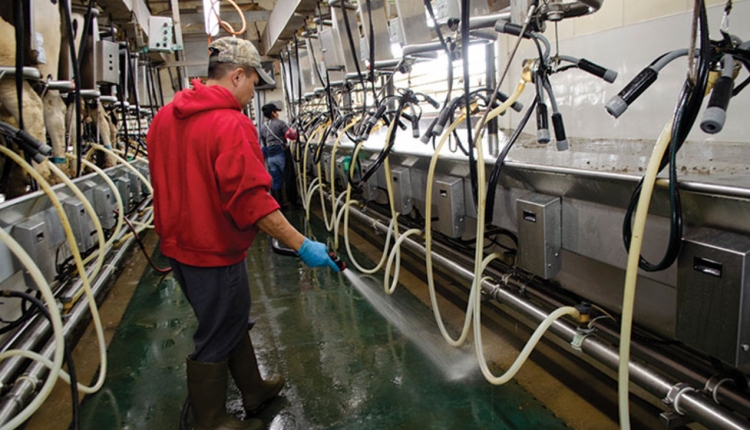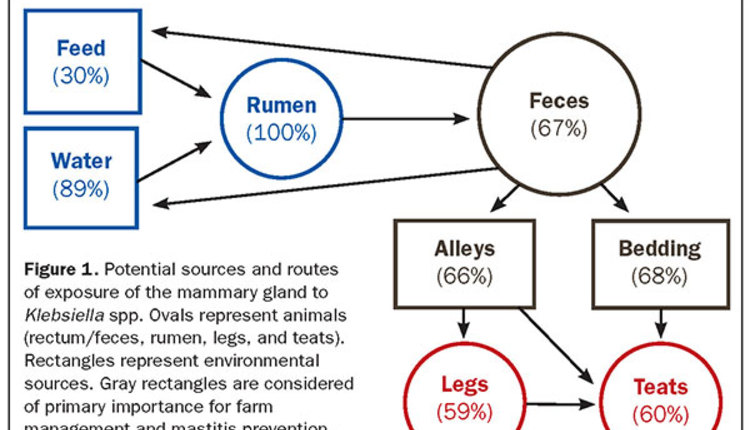The authors are with Quality Milk Production Services, Cornell University.

NAS have been traditionally classified as minor pathogens, and their importance as a cause of subclinical or clinical mastitis is typically limited. In most situations, they only cause a mild rise in somatic cell count (SCC).
The prevalence of NAS mastitis is higher in first-lactation cows than in older cows, and they are not considered as pathogenic as the other microorganisms. NAS have become the most common bovine mastitis isolate in many countries, and Staphylococcus chromogenes and Staphylococcus simulans are currently the predominant NAS species in bovine mastitis. S. chromogenes is the major NAS species affecting first-lactation and older cows, whereas S. simulans has been isolated more frequently from older cows.
Digging deeper
In a Canadian study, 50% of NAS isolates were S. chromogenes and it was also the most prevalent species in a Belgium study. In Canada, S. chromogenes also has the highest of any NAS prevalence in clinical mastitis.
Of all NAS species, S. chromogenes-positive milk samples had the highest SCC followed by S. epidermidis and S. simulans. It is considered an important species in quarters with high somatic cell counts, persistent cases, and clinical mastitis.
It was also reported that S. chromogenes is responsible for significantly elevating SCC in cows with persistent subclinical mastitis as well as for greater inflammatory responses and more pronounced clinical signs in mastitis. One study found that the SCC increase was three times higher in small ruminant NAS than in bovine NAS clinical cases, and another reported an elicited immune response in goats after inoculation with S. chromogenes.
A mystery to solve
At QMPS, we had the opportunity to explore some more details about Staph. chromogenes in a field situation a few years ago. One of our regular clients had been having an issue with a bulk tank SCC greater than 200,000 cells per milliliter. We had cultured the entire herd every six months over the past two years and only identified two Staph. aureus cows. One of these cows was sold and the other was milked last at every milking.
The unfolding situation did not fit our usual pattern since we should have picked up more Staph. aureus due to the regular cultures if this was the primary problem. No other major pathogens were detected, although it was noted that NAS was detected on 52% of the composite samples.
In order to investigate this further, we sent all the NAS to our central laboratory for identification on the MALDI-TOF machine. Surprisingly, 90% of the NAS came back as Staph. chromogenes and 10% as Staph. equorum.
In a discussion with the farm, we then decided to enroll them in a small project in which we would do individual quarter cultures and SCC on each cow over the next two years to track if Staph. chromogenes was leading to chronic high SCC quarters. The farm also started milking all Staph. chromogenes-positive cows last and sending in fresh cow cultures on all cows at one to two weeks fresh. This farm was not using antibiotics during lactation, so none of the Staph. chromogenes cows were treated.
After the first round of individual quarter cultures, it did look like Staph. chromogenes was playing a significant role in their high bulk tank SCC, as 48% of the quarter samples greater than 500,000 cells per milliliter cultured Staph. chromogenes. Another 16% were due to either Staph. aureus or Strep. uberis, and the rest were culture negative.
The story held
Six months later, a similar result was obtained with 42% of the quarter samples greater than 500,000 cells per milliliter culturing Staph. chromogenes. The second significant finding was that 75% of the quarters that previously had cultured Staph. chromogenes were still positive for this bug six months later.
One more issue that became evident is that another 23% of the cows were identified with a new case of Staph. chromogenes. This started to help us understand the scenario that was happening on this farm and that Staph. chromogenes was playing a role in their elevated bulk tank SCC.
Developed a game plan
After further discussion of the situation, it was decided that the herd would agree to selectively use dry cow antibiotic on the Staph. chromogenes-positive cows when they were dried off. In addition, they would continue to milk any known positive Staph. chromogenes cows last, review their milking procedures with all milkers, and culture all fresh cows.
Over the course of the next year, we did see many individual cows cured of Staph. chromogenes during the dry period by dry cow antibiotics, and some would calve in with a low SCC, but not every cow. Gradually, the number of Staph. chromogenes-positive cows dropped, and the bulk tank SCC did finally move below 200,000 cells per milliliter.
Based on our small field trial and the data from other researchers, we believe that Staph. chromogenes can act as a major pathogen in your herds. Also, as we demonstrated, it is associated with high SCC quarters and can be the cause of chronic high SCC quarters in your herds.
This herd appeared to have a contagious mastitis pattern in which there looked to be cow-to-cow spread, although we did not do any strain typing to definitely prove this. If you have herds in a similar situation, it may be worth your time to further explore the non-aureus staphs to determine if Staph. chromogenes may be playing a significant role.









